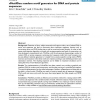55 search results - page 1 / 11 » Computing distribution of scale independent motifs in biolog... |
ALMOB
2006
13 years 5 months ago
2006
The use of Chaos Game Representation (CGR) or its generalization, Universal Sequence Maps (USM), to describe the distribution of biological sequences has been found objectionable ...
RECOMB
2001
Springer
14 years 5 months ago
2001
Springer
motif discovery problem abstracts the task of discovering short, conserved sites in genomic DNA. Pevzner and Sze recently described a precise combinatorial formulation of motif di...
BMCBI
2010
13 years 5 months ago
2010
Background: Large datasets of protein interactions provide a rich resource for the discovery of Short Linear Motifs (SLiMs) that recur in unrelated proteins. However, existing met...
BMCBI
2007
13 years 5 months ago
2007
Background: Detection of short, subtle conserved motif regions within a set of related DNA or amino acid sequences can lead to discoveries about important regulatory domains such ...
BMCBI
2008
13 years 5 months ago
2008
Background: Motif finding algorithms have developed in their ability to use computationally efficient methods to detect patterns in biological sequences. However the posterior cla...

